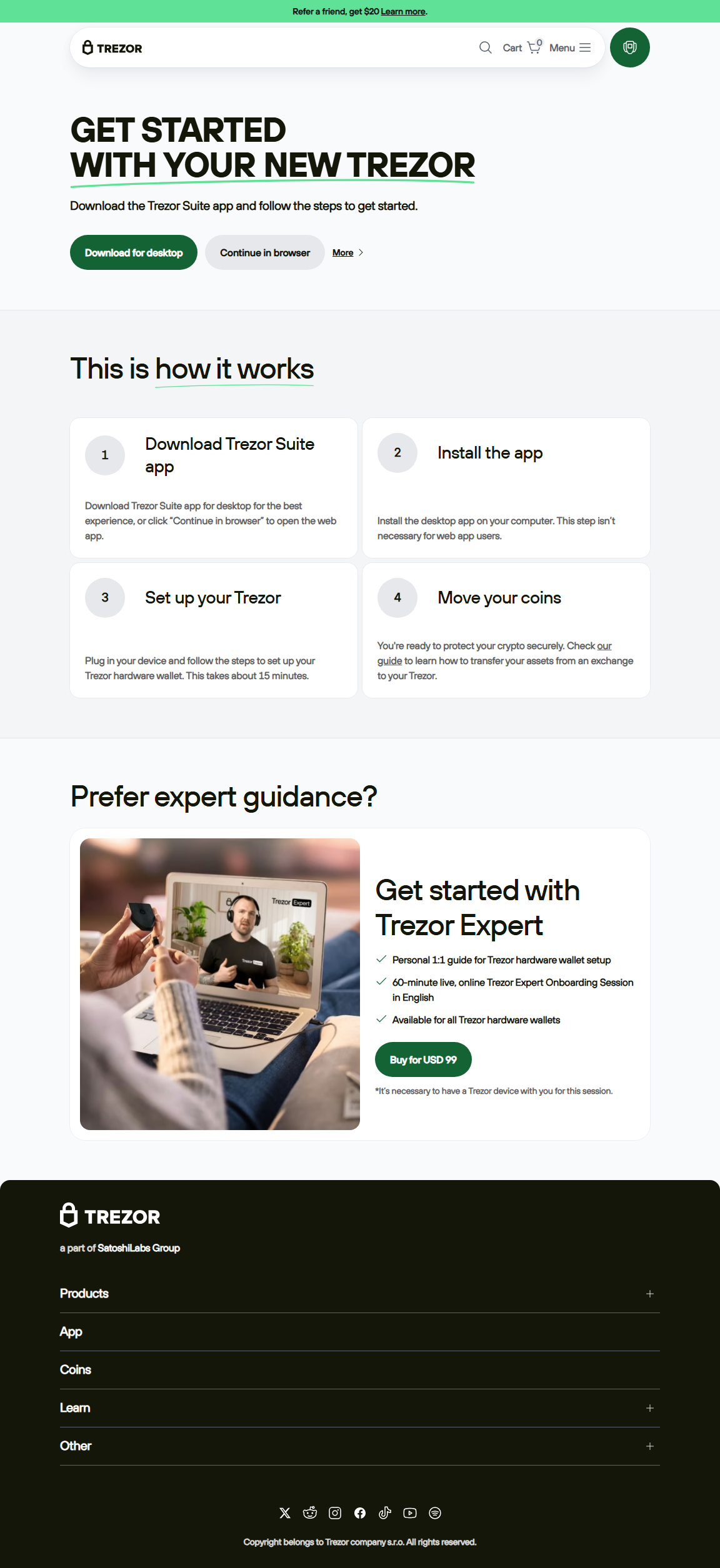Trezor.io/start — The Complete Beginner to Pro Guide for Setting Up Your Trezor Wallet
A beautifully clear, in-depth tutorial on how to use Trezor.io/start — your first step to mastering crypto self-custody, security, and independence.
Why Trezor.io/start Is Your Safe Entry Point
When you open the world of cryptocurrency, security becomes your most valuable ally. Trezor.io/start is the official onboarding gateway for Trezor hardware wallets — ensuring you’re always downloading genuine software, verifying firmware, and following the safest process to generate your recovery seed.
Step-by-Step: Setting Up Trezor at Trezor.io/start
- Unbox your Trezor device. Make sure the holographic seal is intact. Any tampering? Contact Trezor Support immediately.
- Visit Trezor.io/start. You’ll be guided to download Trezor Suite — the secure desktop app that connects you to your wallet.
- Connect your device. Plug it into your computer. The Suite will automatically detect it and prompt you to install or update firmware.
- Generate your wallet and recovery seed. Follow the on-screen instructions. You’ll receive a 12–24 word seed phrase — the only way to recover your crypto if your device is lost.
- Set a PIN. A personal PIN protects unauthorized access. It’s your local security layer.
- Add accounts & receive funds. Once configured, you can create Bitcoin, Ethereum, and other accounts — all secured by your Trezor’s private key.
Trezor Model One vs Model T
| Feature | Trezor Model One | Trezor Model T |
|---|---|---|
| Display | Monochrome OLED (buttons) | Full-color touchscreen |
| Supported coins | 1,000+ | 1,600+ (incl. ERC-20 tokens) |
| Backup options | Standard recovery seed | Seed + Shamir Backup |
| Price range | Budget-friendly | Premium / advanced features |
The Model One is ideal for beginners, while the Model T appeals to advanced users who prefer a touchscreen interface and enhanced backup options.
Advanced Security Tools Explained
1. Passphrase: Your Hidden Wallet Layer
The passphrase acts as a 25th word on top of your recovery seed. It creates an entirely new wallet that only appears when you enter that exact phrase. This “plausible deniability” protects you from theft or coercion scenarios.
2. Shamir Backup: Multi-part Recovery
Available on the Model T, Shamir Backup splits your recovery seed into multiple “shares.” You can require, for example, any 3 out of 5 shares to restore your wallet — meaning no single person can access your funds alone.
3. Firmware Verification
Every firmware update is cryptographically signed by Trezor. The device itself verifies authenticity, so only official firmware can be installed.
Think of Trezor Like a Personal Bank Vault
Your Trezor device is the vault. Your seed phrase is the master key. And Trezor.io/start is the blueprint that ensures the vault is sealed correctly from day one.
Unlike exchanges or custodial wallets, your private keys never leave the device — even when you interact with platforms like MetaMask or DeFi apps. Every signature request must be physically confirmed on your device’s screen.
Crypto Terms You’ll Encounter Along the Way
- Seed Phrase: Your 12–24 word recovery code that regenerates all your wallets.
- Cold Wallet: A device that stores crypto offline, isolated from internet risks.
- Private Key: A unique cryptographic key that authorizes transactions.
- Firmware: The software that runs on your Trezor hardware.
- DeFi (Decentralized Finance): Apps that let you lend, trade, or stake crypto without intermediaries.
FAQ: Quick Answers to Common Trezor Questions
Q1. What happens if I lose my Trezor?
If you have your recovery seed, you can restore your entire wallet — funds, accounts, and addresses — on any new Trezor or compatible hardware wallet.
Q2. Can someone hack my Trezor remotely?
No. Your private keys never leave the device, and all signing happens offline. Only physical access could risk compromise, and even then, your PIN and passphrase protect you.
Q3. Is Trezor Suite better than using a browser extension?
Yes — Suite minimizes phishing risk by running locally on your computer and verifying connections with your device.
Q4. Can I use Trezor with MetaMask or DeFi apps?
Yes. Connect your Trezor through MetaMask’s hardware wallet option to sign DeFi transactions securely while keeping your keys offline.
Your Essential Security Checklist
- Use only Trezor.io/start for setup and firmware updates.
- Write down your recovery seed and keep it offline in multiple safe locations.
- Never enter your seed into a computer or website.
- Enable a PIN and, if possible, a passphrase for hidden wallets.
- Update Trezor Suite and firmware regularly.
- Confirm every address and transaction on the device screen.
Final Thoughts: Real Ownership Begins Here
Trezor.io/start isn’t just a URL — it’s the foundation of digital sovereignty. It empowers you to move from “trusting” an exchange to truly owning your crypto. Whether you’re a newcomer or an intermediate investor, your Trezor wallet bridges simplicity with world-class security.
The beauty of crypto lies in independence — and Trezor gives you the tools to protect that independence without sacrificing usability. Begin safely, stay informed, and always keep your keys offline. Your future self will thank you.
